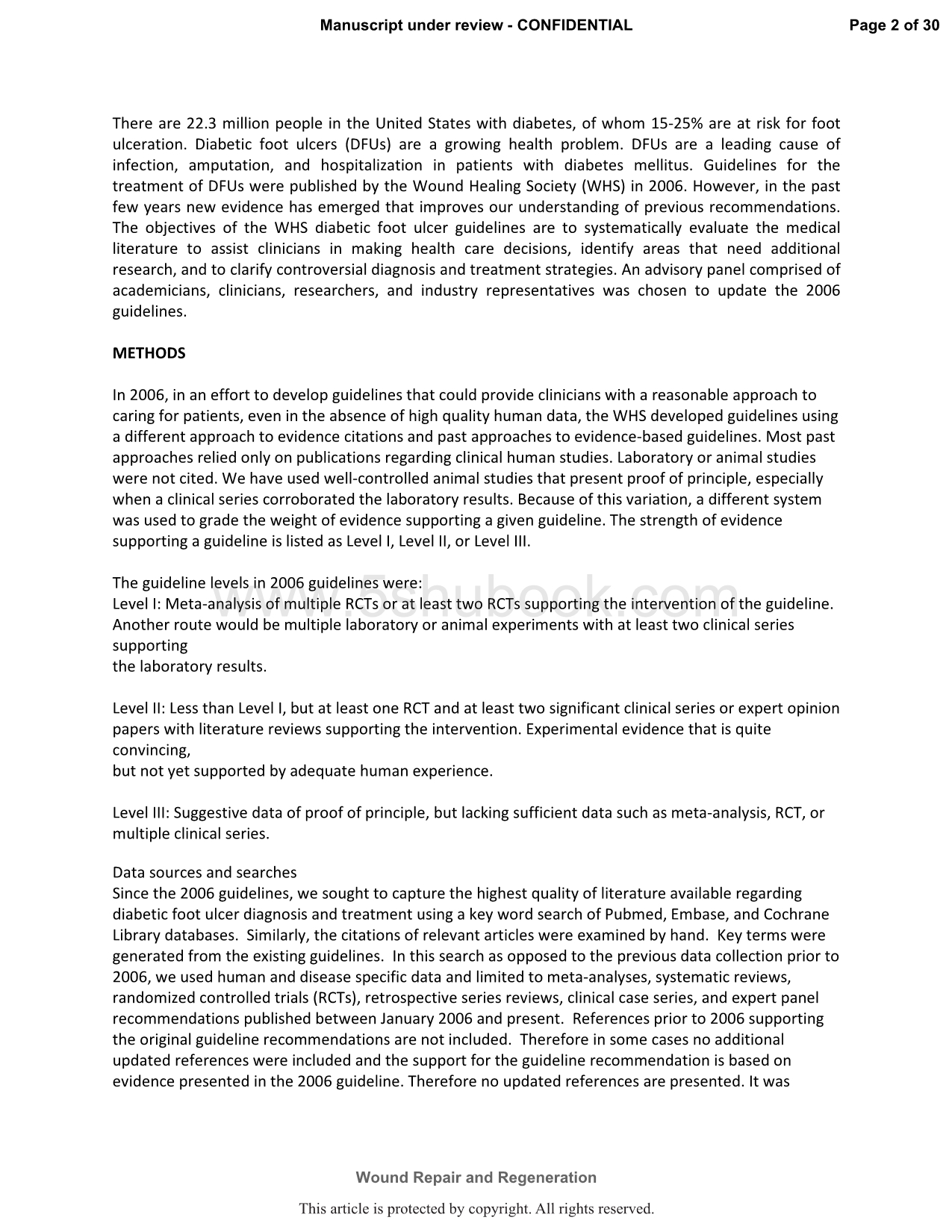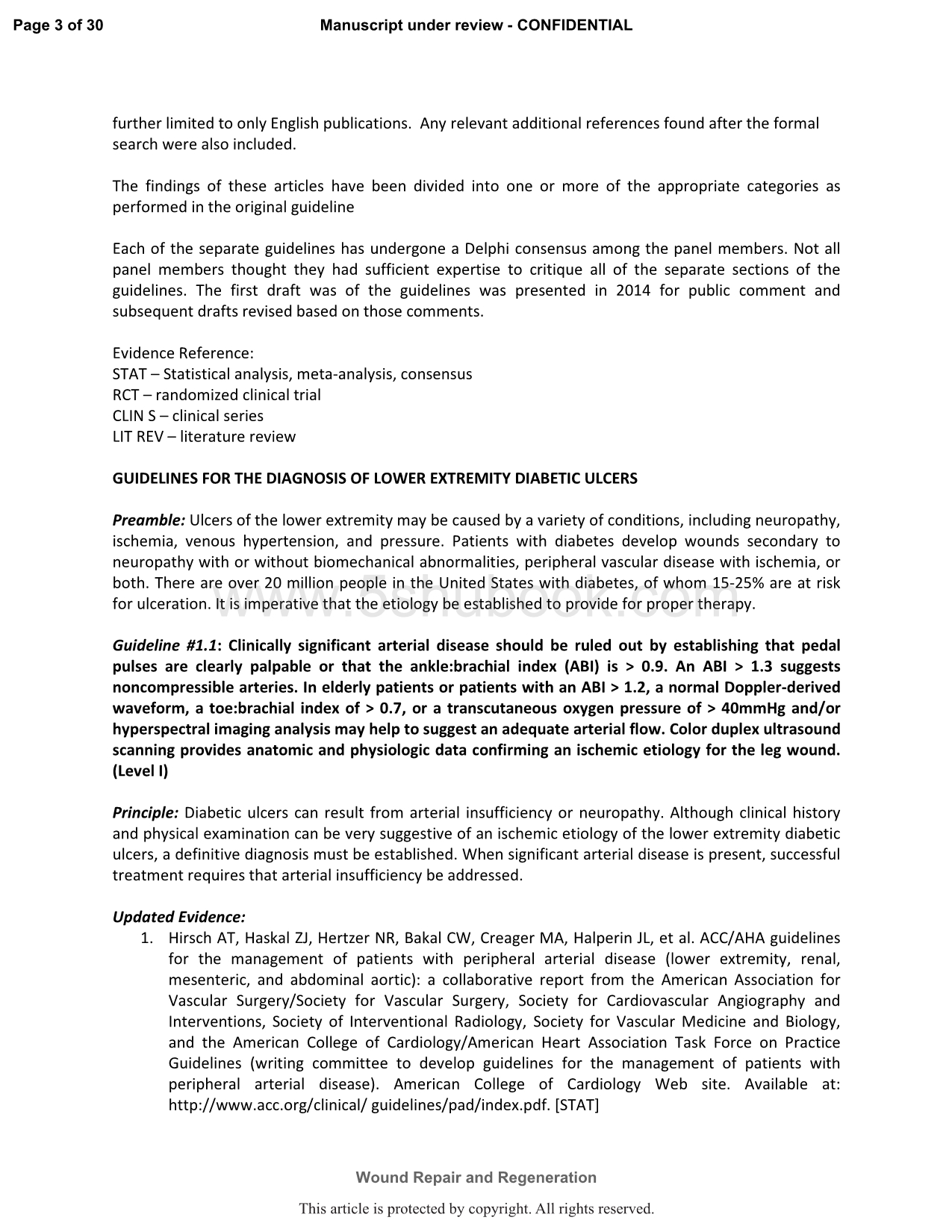
 【医脉通-指南】2015+WHS指南:糖尿病足溃疡的治疗(英文更新版).pdf(30页)
【医脉通-指南】2015+WHS指南:糖尿病足溃疡的治疗(英文更新版).pdf(30页)
《【医脉通-指南】2015+WHS指南:糖尿病足溃疡的治疗(英文更新版).pdf(30页)》由会员分享,可在线阅读,更多相关《【医脉通-指南】2015+WHS指南:糖尿病足溃疡的治疗(英文更新版).pdf(30页)(30页珍藏版)》请在周易易学书店|道易五术书社上搜索。
1、WHS Guidelines Update:Diabetic Foot Ulcer Treatment Guidelines Lawrence A.Lavery DPM,MPH,Department of Plastic Surgery,University of Texas Southwestern Medical Center,Dallas,Texas.Kathryn E.Davis,Ph.D.,Department of Plastic Surgery,University of Texas Southwestern Medical Center,Dallas,Texas.Sandra
2、J.Berriman,Ph.D.,Cardinal Health Wound Management,Pompano Beach,FL Liza Braun,MD,Department of Dermatology,Emory University School of Medicine,Atlanta,GA Adam Nichols,DPM,Department of Orthopaedics,Sanford Health,Sioux Falls SD Paul J.Kim,DPM,MS,Department of Plastic Surgery,Georgetown University,Sc
3、hool of Medicine,Washington,DC David Margolis,MD,PhD,Department of Dermatology,University of Pennsylvania Philadelphia,PA Edgar J.Peters,MD,PhD,Infectious Diseases and Topical Medicine,The Free University of Amsterdam,Amsterdam,the Netherlands.Chris Attinger,MD,Department of Plastic Surgery,Georgeto
4、wn University,School of Medicine,Washington,DC Corresponding author:Lawrence A.Lavery University of Texas Southwestern Medical Center Department of Plastic Surgery 1801 Inwood Road,Dallas Texas 75390-9132 Fax 214-648-2550 Phone 214-648-9114 larry.laveryutsouthwestern.edu Running Title:DFU Guidelines
5、 Key Words:diabetes,foot,ulceration,infection,This article has been accepted for publication and undergone full peer review but has not beenthrough the copyediting,typesetting,pagination and proofreading process which may lead todifferences between this version and the Version of Record.Please cite
6、this article as anAccepted Article,doi:10.1111/wrr.12391This article is protected by copyright.All rights reserved.There are 22.3 million people in the United States with diabetes,of whom 15-25%are at risk for foot ulceration.Diabetic foot ulcers(DFUs)are a growing health problem.DFUs are a leading
7、cause of infection,amputation,and hospitalization in patients with diabetes mellitus.Guidelines for the treatment of DFUs were published by the Wound Healing Society(WHS)in 2006.However,in the past few years new evidence has emerged that improves our understanding of previous recommendations.The obj
8、ectives of the WHS diabetic foot ulcer guidelines are to systematically evaluate the medical literature to assist clinicians in making health care decisions,identify areas that need additional research,and to clarify controversial diagnosis and treatment strategies.An advisory panel comprised of aca
9、demicians,clinicians,researchers,and industry representatives was chosen to update the 2006 guidelines.METHODS In 2006,in an effort to develop guidelines that could provide clinicians with a reasonable approach to caring for patients,even in the absence of high quality human data,the WHS developed g
10、uidelines using a different approach to evidence citations and past approaches to evidence-based guidelines.Most past approaches relied only on publications regarding clinical human studies.Laboratory or animal studies were not cited.We have used well-controlled animal studies that present proof of
11、principle,especially when a clinical series corroborated the laboratory results.Because of this variation,a different system was used to grade the weight of evidence supporting a given guideline.The strength of evidence supporting a guideline is listed as Level I,Level II,or Level III.The guideline
12、levels in 2006 guidelines were:Level I:Meta-analysis of multiple RCTs or at least two RCTs supporting the intervention of the guideline.Another route would be multiple laboratory or animal experiments with at least two clinical series supporting the laboratory results.Level II:Less than Level I,but
13、at least one RCT and at least two significant clinical series or expert opinion papers with literature reviews supporting the intervention.Experimental evidence that is quite convincing,but not yet supported by adequate human experience.Level III:Suggestive data of proof of principle,but lacking suf
14、ficient data such as meta-analysis,RCT,or multiple clinical series.Data sources and searches Since the 2006 guidelines,we sought to capture the highest quality of literature available regarding diabetic foot ulcer diagnosis and treatment using a key word search of Pubmed,Embase,and Cochrane Library
15、databases.Similarly,the citations of relevant articles were examined by hand.Key terms were generated from the existing guidelines.In this search as opposed to the previous data collection prior to 2006,we used human and disease specific data and limited to meta-analyses,systematic reviews,randomize
16、d controlled trials(RCTs),retrospective series reviews,clinical case series,and expert panel recommendations published between January 2006 and present.References prior to 2006 supporting the original guideline recommendations are not included.Therefore in some cases no additional updated references
17、 were included and the support for the guideline recommendation is based on evidence presented in the 2006 guideline.Therefore no updated references are presented.It was Page 2 of 30Wound Repair and RegenerationManuscript under review-CONFIDENTIALThis article is protected by copyright.All rights res
18、erved.further limited to only English publications.Any relevant additional references found after the formal search were also included.The findings of these articles have been divided into one or more of the appropriate categories as performed in the original guideline Each of the separate guideline
19、s has undergone a Delphi consensus among the panel members.Not all panel members thought they had sufficient expertise to critique all of the separate sections of the guidelines.The first draft was of the guidelines was presented in 2014 for public comment and subsequent drafts revised based on thos
20、e comments.Evidence Reference:STAT Statistical analysis,meta-analysis,consensus RCT randomized clinical trial CLIN S clinical series LIT REV literature review GUIDELINES FOR THE DIAGNOSIS OF LOWER EXTREMITY DIABETIC ULCERS Preamble:Ulcers of the lower extremity may be caused by a variety of conditio
21、ns,including neuropathy,ischemia,venous hypertension,and pressure.Patients with diabetes develop wounds secondary to neuropathy with or without biomechanical abnormalities,peripheral vascular disease with ischemia,or both.There are over 20 million people in the United States with diabetes,of whom 15
22、-25%are at risk for ulceration.It is imperative that the etiology be established to provide for proper therapy.Guideline#1.1:Clinically significant arterial disease should be ruled out by establishing that pedal pulses are clearly palpable or that the ankle:brachial index(ABI)is 0.9.An ABI 1.3 sugge
23、sts noncompressible arteries.In elderly patients or patients with an ABI 1.2,a normal Doppler-derived waveform,a toe:brachial index of 0.7,or a transcutaneous oxygen pressure of 40mmHg and/or hyperspectral imaging analysis may help to suggest an adequate arterial flow.Color duplex ultrasound scannin
24、g provides anatomic and physiologic data confirming an ischemic etiology for the leg wound.(Level I)Principle:Diabetic ulcers can result from arterial insufficiency or neuropathy.Although clinical history and physical examination can be very suggestive of an ischemic etiology of the lower extremity
25、diabetic ulcers,a definitive diagnosis must be established.When significant arterial disease is present,successful treatment requires that arterial insufficiency be addressed.Updated Evidence:1.Hirsch AT,Haskal ZJ,Hertzer NR,Bakal CW,Creager MA,Halperin JL,et al.ACC/AHA guidelines for the management



- 配套讲稿:
如PPT文件的首页显示word图标,表示该PPT已包含配套word讲稿。双击word图标可打开word文档。
- 特殊限制:
部分文档作品中含有的国旗、国徽等图片,仅作为作品整体效果示例展示,禁止商用。设计者仅对作品中独创性部分享有著作权。
- 关 键 词:
- 医脉通-指南 医脉通 指南 whs 糖尿病足 溃疡 治疗 医治 英文 新版
 周易易学书店|道易五术书社所有资源均是用户自行上传分享,仅供网友学习交流,未经上传用户书面授权,请勿作他用。
周易易学书店|道易五术书社所有资源均是用户自行上传分享,仅供网友学习交流,未经上传用户书面授权,请勿作他用。









 《风湿病中医特色治疗》·吴启富.pdf(342页)
《风湿病中医特色治疗》·吴启富.pdf(342页)
 【2016爱爱医中医擂台赛】:协定处方院内验方 院内制剂汇集(骨伤科类)天津市中医院.doc(2页)
【2016爱爱医中医擂台赛】:协定处方院内验方 院内制剂汇集(骨伤科类)天津市中医院.doc(2页)
 穴位贴敷疗法(中医特色治疗).ppt(14页)
穴位贴敷疗法(中医特色治疗).ppt(14页)
